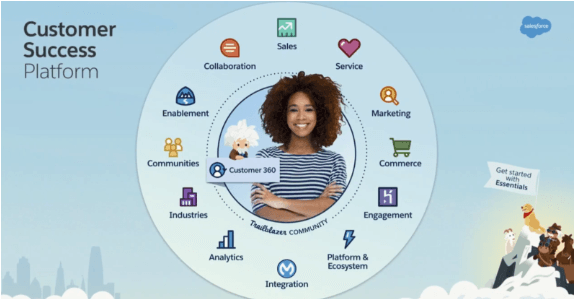- Adam Mansfield
- Reading Time: 5 minutes

With over 170,000 attendees, nearly 3,000 sessions, and millions of online viewers, Dreamforce 2018 was Salesforce’s largest event to date. Having attended the event, it is clear that Salesforce continues to care deeply for its developed community and the culture it has created around its brand. But amid the themes of charity, trust, and mindfulness, life-size Disney-like Salesforce characters, and concerts by Metallica and Janet Jackson, I noticed a few primary topics that customers will likely continue to hear about moving forward, whether they are interested or not.
Salesforce Wants You to Bundle Up with Customer 360

Though Customer 360 is only in pilot and won’t be generally available until next year, customers should expect to hear more about the Customer Success Platform and those that already adopted multiple components should anticipate getting a hard sell over the next 12 months. Given the breadth of the solution coverage, Salesforce representatives will continue to take a divide-and-conquer approach when it comes to selling this bundle by working very hard to demonstrate and sell each department on how the respective product meets their needs. Once buy-in is achieved in multiple areas, the Customer 360 sell becomes that much easier. Companies, especially the large ones, should also expect their CEO to get approached to discuss how Salesforce’s Customer Success Platform will drive a successful digital transformation for the business they are running.
We have already seen, in multiple scenarios, long-standing customers get approached with “bundled” pricing as part of their renewal negotiations. It is very clear that Salesforce wants to establish a precedent for bundled pricing now while also removing line item product pricing transparency, so it will be easier to sell Customer 360 later.
Customer 360 is a Bundle and That is Problematic
Bundling products and going to market with product platforms and/or bundles is a common tactic of IT vendors and especially cloud vendors. Even cable companies use this tactic to strengthen vendor lock-in and increase adoption. If more companies purchase the bundled offering, the vendor has the ability to report higher adoption rates of the products that make up the bundle regardless of how many companies are actually using that particular product. Bundles like Salesforce’s Customer 360 also make it significantly harder for customers to walk away since multiple aspects of their business now depend on Salesforce to function.
What customers should strive for in their upcoming renewals and often challenging negotiations is ensuring that they have the right deal and solution for them. Not all companies will have a need for each product that makes up the Customer Success Platform, Customer 360 bundle, or smaller bundles of Salesforce products that will most likely be pushed if it is too early to approach with the truly “all-in” Customer Success Platform.
It will be important, even if ultimately the bundle is selected, for companies to have line-item-negotiated product pricing as well, so you have pricing readily available to call upon should the time come where the bundle no longer makes sense. It is incredibly difficult to decouple a bundle. The line item product pricing will go up, and more often than not, if you were able to negotiate renewal price protections there will be conditions within them that effectively require you to continue with the bundle or you will be completely exposed to significant price increases. Quite simply, adopting a bundled set of products significantly decreases your go-forward and future leverage if you do not set yourself up appropriately prior to bringing pen to paper.
MuleSoft and the Power of Integration
As expected, MuleSoft was a focal point of Dreamforce and was mentioned throughout the conference. Salesforce acquired MuleSoft for $6.5B earlier this year (Salesforce’s largest acquisition ever) because of its ability to provide businesses a means of connecting applications, devices, and data (whether on-premise or in the cloud) with an API-led approach. This ability to connect all of the customer’s data and a means to “unlock” that data so it becomes available and truly valuable is what has Salesforce so excited and why MuleSoft was prevalent at Dreamforce.
Salesforce understands that MuleSoft is not only valuable as a standalone solution, but it is a critical component to the Customer Success Platform. It essentially ties (i.e., integrates) everything together. MuleSoft is also incredibly important to Salesforce and its go-forward plans and aspirations because its ability to unlock clean and centralized data allows for Einstein, another key solution, to become more valuable to a customer where Salesforce is trying to gain adoption of Einstein. With MuleSoft’s integration capabilities and ability to unlock data, Einstein will be able to tap into the entire dataset, whether pulled from on-premise, cloud, or legacy systems, to provide more powerful insights than previously possible. Salesforce knows this is something they can sell given the importance of digital transformations and they will be aggressively trying to do so.
Einstein Voice Assistant
Another product that was fully introduced at Dreamforce was Einstein Voice Assistant. Salesforce is taking their artificial intelligence (AI) system and machine learning capabilities to the next level by adding natural language processing models. With this capability, sales representatives can quickly update records using voice memos and retrieve data insights via voice commands. This increased level of productivity alone will be incredibly valuable to customers.
They also announced Einstein Voice Bots which will allow companies to create their own branded voice assistant to interact with customers via Google Assistant or Amazon Alexa. However, Einstein Voice Bots won’t be in pilot until June 2019.
New and Stronger Partnerships
In addition to a strong focus on the products mentioned above, Salesforce also announced a new global partnership with Apple that will bring new mobile apps to businesses and expanded their AWS partnership. Salesforce also strengthened their partnership with Google through the announcement that they are now a reseller of Google Analytics 360.
Having partnerships in place with these three tech giants not only provides them a better opportunity to achieve the goals they have set out for themselves in terms of market penetration, product adoption, and revenue growth, but also strengthens itself against competitors like SAP, Oracle, and Microsoft.
The Wrap Up
All you had to do is spend one day at Dreamforce for it to be crystal clear that Salesforce’s focus is and will continue to be on the Customer Success Platform. Customer 360 and the bundling of integrated products and solutions that come with it will be prevalent within sales decks and product demo discussions.
The goal is to get their customers (at least eventually) to adopt a platform rather than a product here and a product there. A key component of this platform comes with the ability to integrate and unlock data across the customer’s business. Knowing this and understanding that getting a customer to jump right into Customer 360 is going to be difficult, Salesforce is going to ramp up its efforts in getting more businesses to adopt and utilize MuleSoft as well.
Customers should prepare for aggressive upselling as part of Salesforce’s consistent objective to “Land and Expand” and unfortunately, provide less transparent pricing on individual products. It will be critical for businesses to ensure that the “let’s get the deal done” discount is actually the best Salesforce can do and that the proper downstream price protections are in place before adding any product or solution to the portfolio.
Related Blogs
Salesforce’s New Agentforce Pricing: What Customers Should Know
Salesforce Product Changes: What You Need to Know and How to Navigate Them
Salesforce Marketing Cloud: Complexity, Licensing, and Negotiation Pitfalls
About the Author
